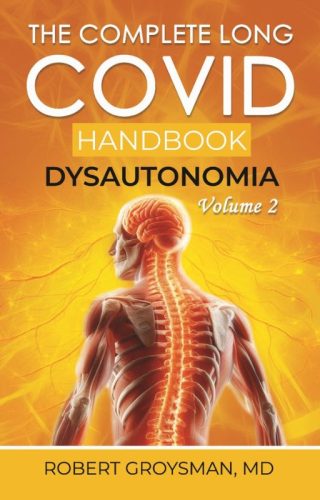Still Fighting Brain Fog, Dizziness, and Crushing Fatigue After COVID?
If you’re tired of being dismissed, misdiagnosed, or told it’s all in your head, this book is your roadmap to real recovery.
If any of these sound familiar, dysautonomia may be the missing diagnosis:
-
Constant fatigue that doesn’t improve with rest
-
Racing heart, anxiety, or sleep that never feels refreshing
-
Weird nerve pain, tingling, tinnitus, or loss of taste and smell

They Said “It’s Just Stress.” They Were Wrong.
Your symptoms aren’t psychological—they’re neurological. Most Long COVID clinics stop at testing. This book goes further: it explains why your autonomic nervous system is out of balance and how to fix it.
Because you deserve more than vague advice and endless referrals.
Inside This Book, You'll Discover...
-
Uncover how dysautonomia creates...
a "multi-car pileup" in your body, explaining why your Long COVID symptoms persist even when tests come back normal (p.10)
-
Why your body may be stuck
in a harmful "fight-or-flight" state, accelerating aging and preventing healing during sleep (p.57-59)
-
Learn why some Long COVID patients experience taste and smell disturbances
and the surprising treatments showing promise for restoration (p.99-101)
-
Discover how the vagus nerve affects over
66-80% of Long COVID cases and the simple at-home stimulation technique that can help restore balance (p.45-50)
-
Understand the simple screening test
you can take at home to assess your level of dysautonomia (p.29-36)
-
Learn why heart rate variability (HRV)
might be the most important measurement for tracking your recovery (p.75-80)
-
Understand why treating dysautonomia
is crucial for recovery, rather than just managing individual symptoms (p.63-65)
What People Are Saying...
I really liked this book, it’s very simple to understand. I bought the book mostly for my family to read so they can see understand what my illness is about. The author is extremely knowledgeable and knows how to treat dysautonomia.
AMJO
This book is just fantastic at breaking down dysautonomia and explaining treatment options for patients. I’ve had dysautonomia long before covid and have been on a search for answers like this for years. Thank you, Dr Groysman, for all the time and dedication you put into this book and helping your patients regain their health.
JULIE
If you are new to Dysautonomia this book is helpful. I personally was hoping for more focus on treatments especially for those of us who developed it due to a virus.
CARLY
This book is a great resource because it covers so much. It begins by describing what the autonomic nervous systems does, which helps to make sense of symptoms that could seem unrelated, but which are are all linked and helps you understand the sections that follow.
LR
Wish I had a book like this a year or so ago. It’s a digestible summary of all this related to dysautonomia – the whys, the treatment options, and where to start. I recommend patients take this along to their first appointment with GPs, as GPs dont have this detail and treatment options available to them. The NHS system is behind the times when it comes to understanding dydautonomia, PoTS, CFS, etc. hats off to Dr Groysman for publishing this – a much needed resource to patients, other Drs, etc.
PHIL
I have long covid, Dysautonomia and I found this book incredibly helpful, I would highly recommend it along with the other books Dr Groysman has written if you have or suspect long COVID this series of books is a must. I eagerly await the next volume on mitochondria.
FG
Meet The Expert Behind The Book
Dr. Robert Groysman, MD is a pioneer in Long COVID treatment. He’s treated thousands of patients since 2020 and has written multiple handbooks on recovery. He combines cutting-edge research with real-world success using interventions like SGB, EAT, and non-invasive vagus nerve therapy.
This isn’t theory. It’s what’s working right now.



-
ThreeBestRated Doctor 6 years in a row
-
Board-Certified Pain Specialist
-
HIPAA Compliant
Frequently Asked Questions
Dysautonomia is a dysfunction of the autonomic nervous system (ANS), which controls automatic bodily functions like heart rate, blood pressure, and digestion. In Long COVID, the virus appears to damage or interfere with the proper functioning of the ANS, particularly by causing an overactive sympathetic (“fight-or-flight”) response and an underactive parasympathetic (“rest and digest”) response. This autonomic imbalance contributes to many Long COVID symptoms including fatigue, brain fog, irregular heart rate, dizziness, and digestive problems.
Common dysautonomia symptoms include dizziness when standing up, rapid or irregular heartbeat, fatigue, brain fog, digestive problems, and temperature regulation issues. You might also experience headaches, trouble sleeping, tingling sensations, coat hanger pain (pain in head, neck and shoulders), shortness of breath, cold hands or feet, anxiety, and sensory changes like abnormal taste and smell. If you’re experiencing multiple symptoms across different body systems that worsen with physical exertion, dysautonomia may be a contributing factor.
Several treatments that target dysautonomia have shown promise, including Stellate Ganglion Block (SGB), Vagus Nerve Stimulation (VNS), and Epipharyngeal Abrasive Therapy (EAT). SGB has been particularly effective for symptoms like brain fog, smell/taste disturbances, and chronic fatigue. Medications that may help include beta blockers, fludrocortisone, and pyridostigmine. Treatment is highly individualized and often requires a combination approach targeting multiple aspects of the condition.
This symptom is called Post-Exertional Malaise (PEM), which is common in Long COVID-related dysautonomia. When you have dysautonomia, your body struggles to properly regulate energy distribution and recovery after activity. Your autonomic nervous system doesn’t “refuel” properly after exertion, leading to a crash that can last for days, weeks, or even longer. This is why carefully paced, gradual activity rather than pushing through fatigue is recommended for recovery.
Recovery from Long COVID dysautonomia typically takes several months, and improvement usually happens gradually rather than immediately following treatment. The book notes that recovery is unlikely to occur within hours, days, or even weeks. Many patients see progressive improvement with appropriate treatment, but patience and consistency are essential. The timeline varies significantly between individuals, depending on severity, pre-existing conditions, and how promptly treatment is initiated.
Yes, dysautonomia can explain the diverse, seemingly unrelated symptoms you’re experiencing. The autonomic nervous system controls many automatic functions throughout your body, including heart rate, blood pressure, digestion, temperature regulation, and more. When this system malfunctions, it can cause widespread effects across multiple body systems. This is why Long COVID is often described as a “multi-car pileup” – while there’s a common cause (autonomic dysfunction), each person experiences different symptoms requiring individualized treatment approaches.
Start Healing Today
Discover How to Reset Your Nervous System
Your symptoms are giving you clues, now it’s time to understand what you’re body is trying to tell you.
(Physical or Kindle version available)
© 2025 COVID Institute · This information is considered medical advice, to treat or cure any condition or disease. Please use at your own risk. For information use only. Consult your physician before starting any protocol.